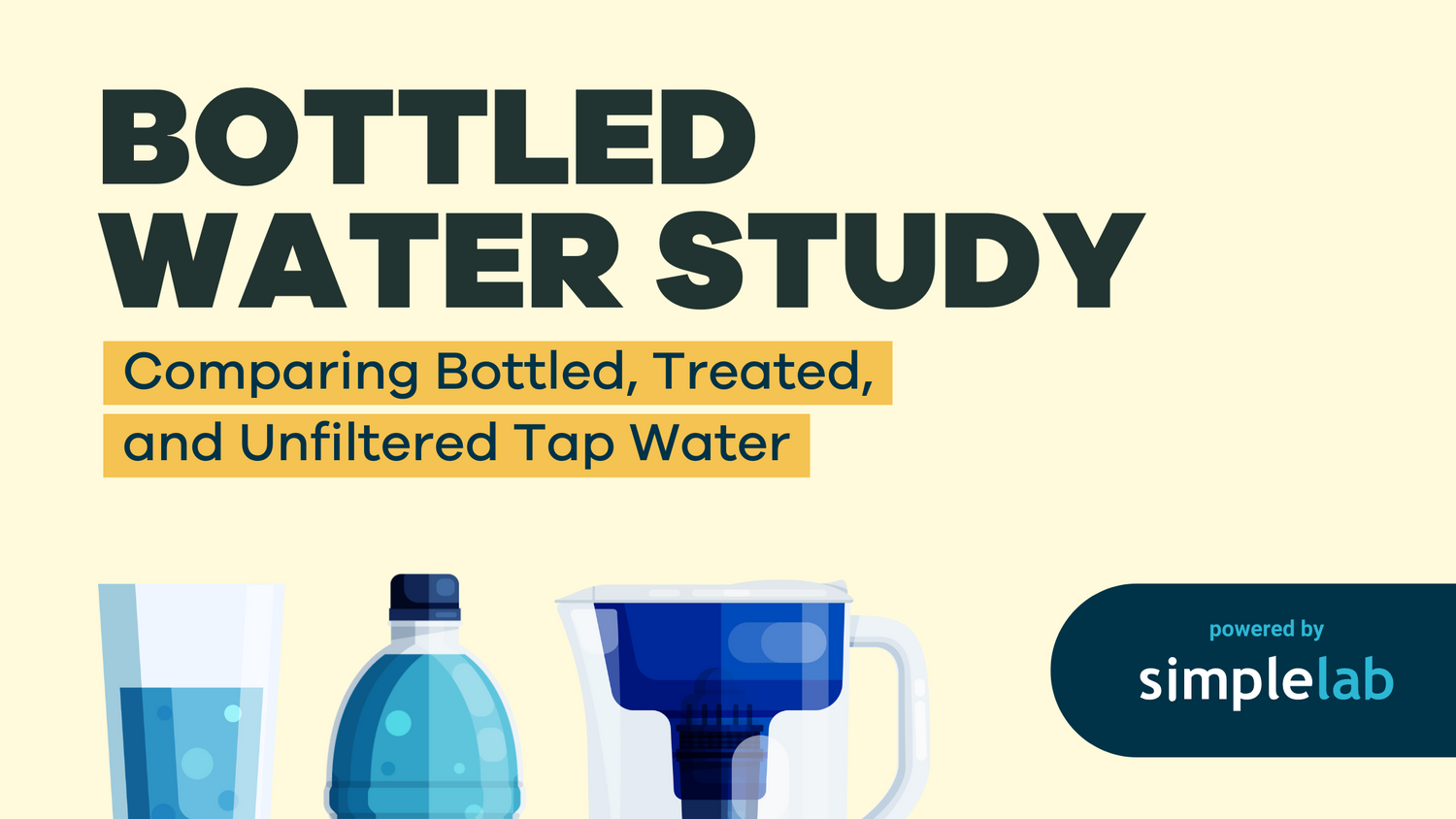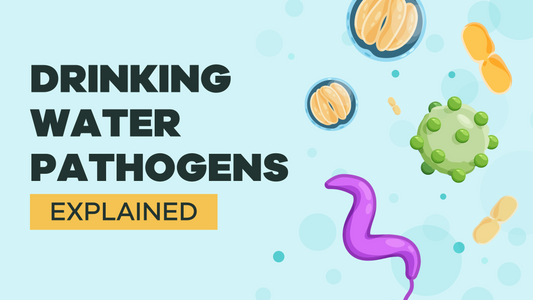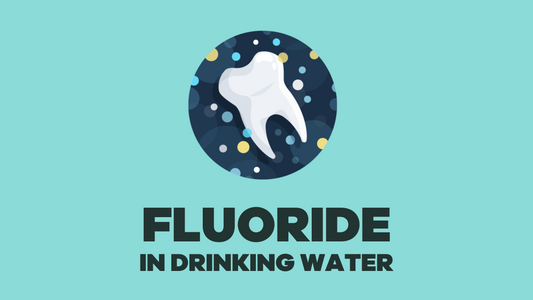
Understanding the Risks in Your Drinking Water
Our blog is written by real experts— not AI. Each guide is carefully reviewed and updated based on the latest research. Plus, with no affiliate links, you can count on unbiased insights you can trust.
We all want to drink water that's safe and tastes good. But with aging public utilities and increasing environmental concerns, threats to water quality are more pressing than ever. How do we know which drinking water options—tap, treated tap, or bottled—are best for us from a health, financial, and environmental impact perspective?
The Science Team at our parent company, SimpleLab, sought to answer this question in a recent, peer-reviewed study published in PLOS Water.
In this blog, we’ll summarize the takeaways from the publication in the following sections:
- Study Design and Approach
- Main Findings
- Implications for Your Drinking Water
- Tap Score Data Driving Scientific Research
- What's the Takeaway?
Study Design and Approach
This study evaluated water quality across three common consumer options in the San Francisco Bay Area:
- Bottled water (BW)
- Tap water (TW)
- Household-treated tap water (HTTW)
The results of this analysis illuminate the trade-offs people face in terms of potential health risks and aesthetic concerns across the three most popular drinking water options available.
Here’s a closer look at how the study was conducted:
Where Did the Data Come From?
- Bottled Water
SimpleLab researchers collected 100 bottled water samples, representing 89 different brands, from 82 stores across nine counties in the Bay Area. These samples were chosen to reflect the market share of bottled water products sold in the U.S. in 2022— i.e., a mix of groundwater-sourced (e.g., spring, artesian, etc) products, purified products, and products that did not meet FDA requirements for any official bottled water categories.
Products were purchased from a range of brands, from big, recognizable names to small private brands. The goal was to get a snapshot of the average options available to consumers in the area. - Tap Water
Anonymized tap water samples were analyzed from 603 households that purchased consumer test-kit products from Tap Score™ between 2021-2022. These samples were from household taps connected to various water utilities in the Bay Area, providing a broad overview of the water quality across the nine-counties. - Household-Treated Tap Water
Anonymized tap water samples were analyzed from 111 households that purchased Tap Score™ test-kits between 2021-2022 and indicated that their sample was treated by an in-home treatment unit. Importantly, pH adjustment and water softening were not included as “treatment” units. These samples were also from household taps connected to various utilities in the Bay Area, but the water was further treated with technologies like carbon filters or reverse osmosis systems.
What Contaminants Were Measured?
The study focused on 100 different analytes, including metals, other inorganics, disinfection byproducts, other volatile organic compounds (VOCs), and general water quality characteristics.
Additionally, three bacteriological indicators were analyzed in bottled water samples. This wide range of analytes was selected to cover both common and emerging contaminants. The study did not look at microplastics, PFAS, or other contaminants that could be present in all three drinking water options. Samples were analyzed using EPA-approved methods at accredited laboratories.
How Were Health Risks and Aesthetic Concerns Evaluated?
SimpleLab researchers compared the results for analytes that have potential health or aesthetic impacts against health and aesthetic benchmarks, where available. A benchmark is the concentration above which an analyte has a potential risk, whether it is health related—for example, an increased risk of cancer—or an aesthetic impact—meaning an impact on the taste, odor or color of the water. A given analyte can have a health benchmark, an aesthetic benchmark, both—or neither!
For each contaminant in each sample, the researchers divided the contaminant’s measured concentration by its corresponding health benchmark–a ratio known as a “toxicity quotient” (TQ). To understand the potential health risk of all of the analytes present in a particular water sample, researchers then calculated “cumulative toxicity quotients” ∑TQs, meaning that all of the individual contaminant toxicity quotients were added together to get one number representing “cumulative toxicity” for each sample. This allowed the researchers to compare the potential toxicity of each water sample, as well as make comparisons across each group of water samples (bottled water, tap water, and household-treated tap water).
Main Findings
The results of comparing water quality to aesthetic and health benchmarks, as well as quantifying potential toxicity, resulted in four major findings.
- Contaminants causing taste, odor or color issues were found in all three drinking water options, but less so in bottled water
Aesthetic issues with tap water is a known driver of people choosing to drink bottled water. Twenty four percent of bottled water samples, 44% of household-treated water samples, and 41% of tap water samples had at least one aesthetic benchmark exceedance. This highlights that no drinking water option is entirely free from potential aesthetic issues. However, the study found that, compared with bottled water, tap water and household-treated water often exceeded taste and odor thresholds for contaminants like magnesium and sodium, as well as thresholds for iron and copper, in a higher proportion than the bottled water samples. These exceedances can affect the flavor and appearance of the water, leading people to choose alternatives to their tap water. - Contaminants were found above health-protective levels in samples across all three drinking water options, but most exceedances happened in tap water
Health benchmarks were exceeded in 53% of bottled water samples, 61% of household-treated water samples, and 98% of tap water samples. Notably, contaminants like lead and arsenic were detected across all drinking water options. This indicates that potential health risks were present in bottled water, tap water, and household-treated tap water.
Potential health risks across the three drinking water options were largely driven by the presence of trihalomethanes (THMs). Trihalomethanes are common contaminants that form when chlorine-based disinfectants used by utilities react with natural organic matter from source water.
Metals drove the remaining health risks across all three sources. In tap water and household-treated tap water, metals like lead, copper, and nickel were prevalent. Whereas in bottled water, arsenic and uranium were responsible for metals-driven potential toxicity. - Average cumulative toxicity of all samples from bottled water was not statistically different from that of household-treated tap water samples
One of the most significant findings from the study was that the cumulative toxicity of household-treated tap water was not statistically significantly different from that of bottled water. This suggests that, from a toxicity standpoint, treating tap water at home can be as effective–on average–as relying on bottled water.
Cumulative toxicity quotients ∑TQs were calculated for each sample by summing the individual toxicity quotients–or the detected contaminant concentrations divided by their health benchmarks for each sample. Welch's one-way ANOVA–a statistical test for comparing averages among groups–was then used to evaluate the differences in average ∑TQs among samples in the three water sources. The results showed that tap water had significantly higher potential toxicity than both bottled water and household-treated tap water. However, the difference in average cumulative toxicity between bottled water and household-treated tap water was not statistically significant.
Implications for Your Drinking Water
The research study results are specific to the samples tested. But some key implications follow from the findings listed above that can inform how individuals, and policymakers, think about their drinking water options.
- Household-treated tap water and bottled water aren’t that different, on average, but treating your tap is cheaper for you and better for the environment
The finding that household-treated water has similar toxicity levels to bottled water suggests that in-home water treatment systems can be highly effective. However, their effectiveness depends on proper selection, installation, and maintenance. There was still a large range of contaminants that exceeded their health benchmarks in household-treated tap water, which suggests that people choosing to treat their water need to improve their treatment choices to ensure they match the water quality identified in their water. - Policies to support utilities working with households around household-scale treatment could address health risks
The study findings suggest that while household-treated water can be a viable alternative to tap and bottled water, it's crucial to ensure these systems are properly maintained and suitable for the specific water quality issues faced. Policymakers and consumers alike need to be informed about the complexities of water quality to make the best decisions for health and safety. Policymakers could consider supporting household-scale treatment systems, especially in areas where municipal water quality is inadequate. Programs providing guidance, education, and financial assistance for selecting and maintaining these systems could be beneficial. - Better optimizing for trihalomethanes (THMs) reduction by utilities would have a dramatic impact on potential toxicity of tap water and, subsequently, household-treated tap water
The research findings indicate that potential toxicity is highest in tap water, even if the tap water samples are within regulatory limits. The results indicate that municipal water treatment processes to better control the formation of trihalomethanes would greatly reduce potential toxicity in tap water and household-treated tap water. While many utilities have already switched from the use of chlorine to chloramines for disinfection in order to reduce trihalomethanes concentrations of trihalomethanes are still higher than is ideal from the perspective of long term health impacts. Potential mitigation strategies could involve further optimizing disinfection methods and reducing the organic matter that leads to trihalomethane formation. Current maximum contaminant levels are likely too high to result in meaningful change around toxicity, and thus new policy mechanisms to incentivize utility management of trihalomethanes will be needed to protect public health.
Critically, even for consumers that drink bottled water only, trihalomethanes in tap water pose a risk–as the primary exposure route and health risks are from inhalation (boiling on the stove or showers). - Aging infrastructure and pipes likely contribute to potential toxicity of tap water and household-treated tap water
After trihalomethanes, metals like lead and copper that are often found in on-premise plumbing were responsible for the higher toxicity potential of tap water samples in the study. The most common cause of these contaminants at the tap is aging infrastructure and old pipes. Investment in infrastructure upgrades to reduce contamination from aging pipes and fixtures continues to be essential.
Tap Score Data Driving Scientific Research
The SimpleLab research team’s peer-reviewed study summarized above is one of the first to evaluate potential health risks and aesthetic concerns across three common drinking water options. This work was made possible by the fact that citizen scientists are testing their drinking water with Tap Score.
The summary statistics from anonymized Tap Score tests makes it possible to inform comparisons among drinking water options in a way that has never been done before.
The result? SimpleLab researchers demonstrated the value of comparing water quality among drinking water options to understand potential risks and identify strategies to improve water quality for everyone.
What’s the Takeaway?
This study reveals important insights into the water quality of bottled water, tap water, and household-treated tap water in the San Francisco Bay Area. Main takeaways include:
- All Water Sources Have Aesthetic Concerns: Bottled water generally has fewer issues with taste, odor, and color, but no option is completely free from these problems.
- Health Risks Are Present in All Drinking Water Options: Tap water poses the highest potential health risks, especially due to trihalomethanes, though bottled and household-treated water also have notable health benchmark exceedances.
- Household-Treated Water Can Match Bottled Water in Quality: Properly maintained household water treatment systems can reduce potential toxicity levels to those similar to bottled water, providing a more cost-effective and environmentally friendly alternative.
Consumers should weigh these factors, considering at-home water treatment as a viable and more sustainable option, while recognizing the need for informed choices and advocating for policy and infrastructure improvements to ensure safe and clean water for all.









